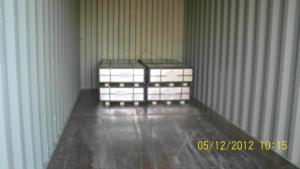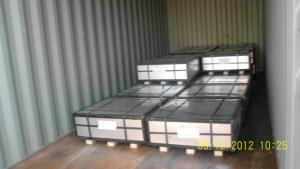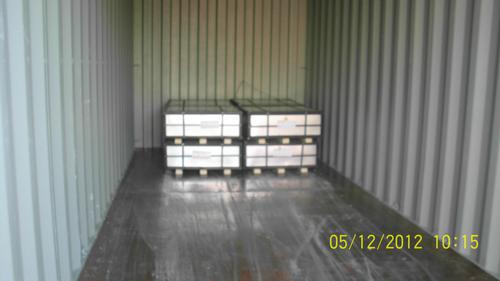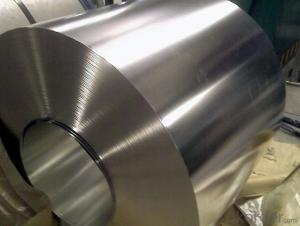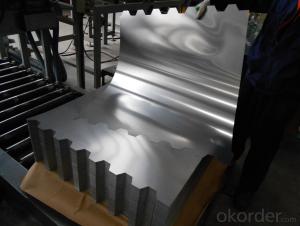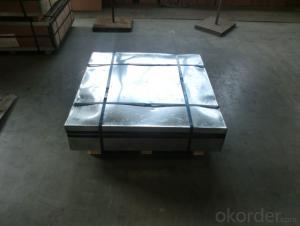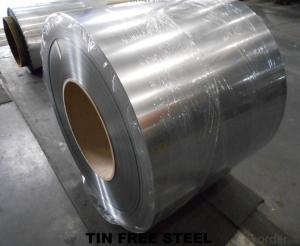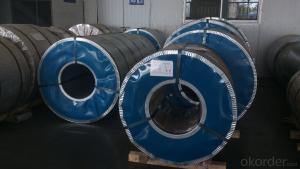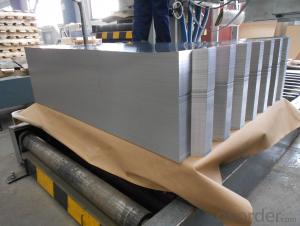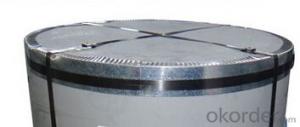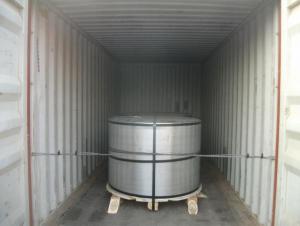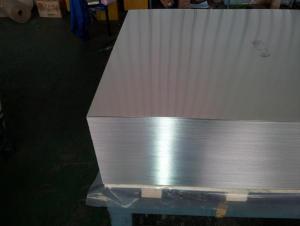Tin Free Steel - TFS SHEET
- Loading Port:
- China Main Port
- Payment Terms:
- TT OR LC
- Min Order Qty:
- -
- Supply Capability:
- -
OKorder Service Pledge
OKorder Financial Service
You Might Also Like
Tin Free Steel (TFS)
Is also known as chromed steel, as it is obtained by coating the metal base (low-carbon steel) with an ultra-thin layer of metallic chrome and then with a chromium oxide layer.This steel product was developed to meet economic requirements, and excels tinplate in paintability, paint adhesion, and economy. It is widely used for making beverage cans and 18-liter cans. It is also used for making photographic film cases and as a protective material for optical fiber cables.
Our TFS Specification:
Standard: AISI, ASTM, BS, DIN, GB, JIS
Material: MR,SPCC
Thickness:0.15mm - 0.45mm
Width: 600mm -1150mm
Temper: T1-T5
Annealing: BA & CA
Coil Inner Diameter: 508mm
Weight: 6-10 tons/coil 1~1.7 tons/sheets bundle
Oil: DOS
Surface: Finish,bright,stone,matte,silver
Packing:
1、For sheets: plastic or waterproof paper, metallic cover and angles, steel strips,wooden pallet.
2、For Coils: plastic or waterproof paper,plastic protect plate,steel strips.
Both Prime and Second Quality Are Available!!!
- Q: How does tinplate perform in terms of heat resistance?
- Tinplate has a relatively low heat resistance compared to other metal materials. It can withstand moderate temperatures without significant deformation or damage, but it is not suitable for high-temperature applications.
- Q: How does tinplate contribute to the resistance of marine equipment?
- Tinplate contributes to the resistance of marine equipment by providing a protective barrier against corrosion. The tin coating on the steel substrate acts as a sacrificial layer that prevents the underlying metal from coming into contact with moisture and saltwater, which are common in marine environments. This corrosion resistance property of tinplate helps to prolong the lifespan of marine equipment and ensures its durability even in harsh conditions.
- Q: What are the main trends in the tinplate industry?
- The main trends in the tinplate industry include a growing demand for sustainable packaging solutions, increased focus on product innovation and customization, the adoption of advanced technology for production efficiency, and a shift towards lightweight and cost-effective packaging materials. Additionally, there is a rising preference for tinplate packaging in the food and beverage sector due to its durability, versatility, and ability to maintain product quality and freshness.
- Q: How does tinplate perform in terms of light protection?
- Tinplate performs fairly well in terms of light protection. Its metal composition provides a good barrier against light, preventing the penetration of UV rays and reducing the risk of light-induced degradation or spoilage of the contents. However, its light protection capabilities may vary depending on the thickness and quality of the tin coating applied to the steel substrate.
- Q: What are the different printing techniques used on tinplate?
- There are several different printing techniques used on tinplate, including lithography, offset printing, screen printing, and digital printing. These methods allow for high-quality and vibrant designs to be applied to tinplate surfaces, making them suitable for various packaging and promotional materials.
- Q: What are the different ways to seal tinplate containers?
- There are several ways to seal tinplate containers. Some common methods include using adhesive seals, heat sealing, crimping, or soldering. Adhesive seals involve applying a layer of adhesive to the container's lid, which is then pressed onto the container to create a secure seal. Heat sealing utilizes heat to melt a layer of plastic or wax on the lid, creating a tight bond when cooled. Crimping involves folding and pressing the edges of the container and lid together to create a tight seal. Soldering, on the other hand, uses a heated soldering iron to melt solder onto the seams of the container, creating a strong and permanent seal.
- Q: Can tinplate be used for packaging beverages?
- Yes, tinplate can be used for packaging beverages. Tinplate is a type of steel coated with a layer of tin, which provides excellent protection against corrosion and acts as a barrier against light, oxygen, and moisture. This makes it an ideal material for packaging beverages, as it helps to maintain the quality, freshness, and shelf life of the product. Additionally, tinplate cans are lightweight, durable, and recyclable, making them a sustainable choice for beverage packaging.
- Q: Can tinplate be used for packaging confectionery products?
- Yes, tinplate can be used for packaging confectionery products. Tinplate is a commonly used material for food packaging due to its durability, resistance to corrosion, and ability to maintain product freshness. It provides a safe and secure packaging option for confectionery items, ensuring a longer shelf life and preserving the quality of the products.
- Q: What are the different types of tinplate coatings available?
- There are several different types of tinplate coatings available, including tin-free steel (TFS), electrolytic chromium-coated steel (ECCS), and tin-coated steel. These coatings provide varying levels of protection against corrosion and can be chosen based on specific requirements and applications.
- Q: What are the challenges in printing on tinplate?
- One of the challenges in printing on tinplate is ensuring the adhesion of ink to the metal surface. Tinplate has a smooth and non-porous surface, which makes it difficult for ink to adhere properly. Special primers and coatings may be required to promote better ink adhesion. Additionally, the curved shape of tinplate cans can pose challenges in achieving consistent and accurate printing, as the surface may not be completely flat. Proper registration and alignment techniques need to be employed to overcome this challenge. Another challenge is the durability of the printed design. Tinplate cans often undergo various handling and storage conditions, such as stacking and transportation, which can cause the printed design to scratch or fade over time. Therefore, using high-quality inks and coatings that offer good resistance to abrasion and fading is important.
Send your message to us
Tin Free Steel - TFS SHEET
- Loading Port:
- China Main Port
- Payment Terms:
- TT OR LC
- Min Order Qty:
- -
- Supply Capability:
- -
OKorder Service Pledge
OKorder Financial Service
Similar products
Hot products
Hot Searches
Related keywords
